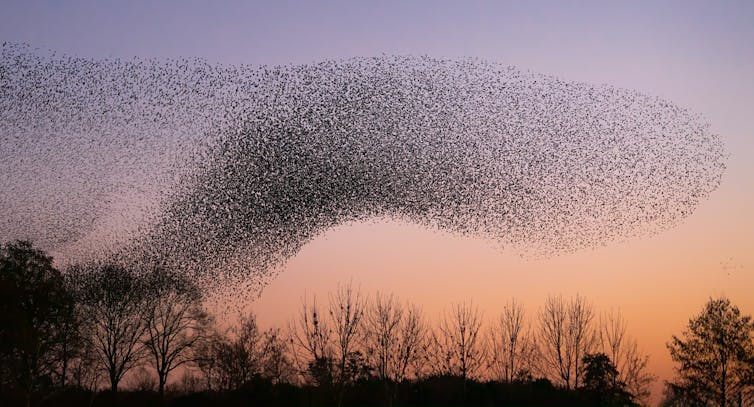[Source: @danbydraws]
Anticipation [Comic]
[Source: @adhdinos]
Who God Turns to For Advice? [Comic]
[Source: @theimmortalgrind]
How swarming animals can help humans and AI make better decisions

Samuel Johnson, University of Oxford
The word swarm often carries negative connotations – think biblical plagues of locusts or high streets full of last-minute shoppers during the Christmas rush. However, swarming is essential for the survival of many animal collectives. And now research into swarming has the potential to change things for humans too.
Bees swarm to make their search for new colonies more effective. Flocks of starlings use dazzling murmurations to evade and confuse predators. These are just two examples from nature but swarming can be seen in almost every corner of the animal kingdom.
Research from mathematicians, biologists and social scientists is helping us understand swarming and harness its power. It’s already being used for crowd control, traffic management and to understand the spread of infectious diseases. More recently, it’s starting to shape how we use data for healthcare, operate drones in military conflicts and has been used to beat near-insurmountable betting odds in sporting events.
A swarm is a system that is greater than the sum of its parts. Just as many neurons form a brain capable of thought, memory and emotion, groups of animals can act in unison to form a “super brain”, displaying highly complex behaviour not seen in individual animals.
Artificial life expert Craig Reynolds revolutionised the study of swarming in 1986 with the publication of the Boids model computer simulation. The Boids model breaks down swarming into a simple set of rules.
The Boids (bird-oids) in the simulation, like avatars or characters in a video game, are instructed to move in the same direction as their neighbours, move towards the average position of their neighbours, and avoid collisions with other boids.
Boids simulations are strikingly accurate when compared with real swarms.
The Boids model suggests that swarming does not need leaders to coordinate behaviour – like pedestrians in a town centre rather than a guided museum tour. The complex behaviour we see in swarms arises from interactions between individuals following the same simple rules in parallel. In the language of physics, this phenomenon is known as emergence.
The hive mind
In 2016, US technology company Unanimous AI used the power of swarm intelligence to win the Kentucky Derby “superfecta” bet, successfully predicting the first, second, third and fourth-placed riders in the famous US horse race.
Industry experts and conventional machine learning algorithms made swathes of incorrect predictions. However, amateur racing enthusiasts recruited by Unanimous AI pooled their knowledge to beat the 541/1 odds.

The volunteers’ success lay in the way in which their predictions were generated. Instead of voting on riders and aggregating their choices, the volunteers used Unanimous AI’s swarm intelligence platform to participate in a real-time digital tug of war, inspired by swarms of birds and bees.
All volunteers simultaneously pulled a dial towards their respective choices. This allowed people to change their preferences in response to the actions of others (for example, a person may have switched to pulling towards their second choice, B, rather than their first choice, C, if they saw A and B were the clear favourites).
Responding to one another in real time allowed Unanimous AI’s volunteers to collectively outperform highly-informed individuals.
What’s more, had the most frequent individual picks of the volunteers determined the ordering, only the 2016 winner and bookies’ favourite, Nyquist, would have been placed correctly.
Health concerns
Similar swarming technologies are also of increasing interest in the healthcare sector, where talk of an AI revolution is prompting increasing concerns around patient privacy.
As the reliance on data-driven techniques in healthcare increases, so too does the demand for extensive patient datasets. One way to meet these demands is to pool information between institutions and in some cases, countries.
However, the transfer of patient data is often subject to stringent data protection regulations. A solution to this problem is to use only in-house data, though this often comes at the expense of diagnostic accuracy.
An alternative lies in swarming. Researchers believe swarm intelligence can preserve diagnostic accuracy without the need for raw data exchange between institutions.
Preliminary studies have shown decentralising data storage into a network of interacting nodes can give institutions the benefit of shared wisdom. This means there isn’t a central hub coordinating the flow of information, and institutions can’t access the private patient data of each other.
Centralised machine learning uses data uploaded to a shared hub where machine learning takes place using all available data. In decentralised systems, each institution separately stores its data in its own node. The machine learning happens locally at each node (using only in-house data), but the results of machine learning are shared between the network, to the benefit of all nodes. This process ensures that raw patient data is not exchanged between institutions, preserving patient privacy.

Swarms and warfare
Drone technology is increasingly used in front-line combat, in recent times most notably by Ukrainian forces in the ongoing Russia-Ukraine conflict. However, as it stands, conventional drone technology requires one-to-one supervision.
Current defence research aims to facilitate communication between drones, allowing one controller to operate swarms of drones. The development of such technology promises to vastly improve the scalability, reconnaissance and striking capabilities of combat drones by allowing for continuous information relay within groups of drones.
As research delves deeper into swarming, we find a world where collective action creates complexity, adaptability, and efficiency. As technology evolves, the role of swarm intelligence is set to grow, intertwining our world with the fascinating dynamics of swarms.
Samuel Johnson, DPhil Candidate in Mathematical Biology, University of Oxford
This article is republished from The Conversation under a Creative Commons license. Read the original article.
What’s My Password Again? [Comic]
[Source: @war.and.peas]
Can you believe this guy? [Comic]
Cool Tips for Curing Your Hangover [Comic]
[Source: Loldwell]
Greek Deli [Comic]
[Source: @war.and.peas]
Cats first finagled their way into human hearts and homes thousands of years ago – here’s how

Jonathan Losos, Arts & Sciences at Washington University in St. Louis
A few years ago, I had the opportunity to go on safari in southern Africa. One of the greatest thrills was going out at night looking for predators on the prowl: lions, leopards, hyenas.
As we drove through the darkness, though, our spotlight occasionally lit up a smaller hunter – a slender, tawny feline, faintly spotted or striped. The glare would catch the small cat for a moment before it darted back into the shadows.

Based on its size and appearance, I initially presumed it was someone’s pet inexplicably out in the bush. But further scrutiny revealed distinctive features: legs slightly longer than those of most domestic cats, and a striking black-tipped tail. Still, if you saw one from your kitchen window, your first thought would be “Look at that beautiful cat in the backyard,” not “How’d that African wildcat get to New Jersey?”
As an evolutionary biologist, I’ve spent my career studying how species adapt to their environment. My research has been reptile-focused, investigating the workings of natural selection on lizards.
Yet, I’ve always loved and been fascinated by felines, ever since we adopted a shelter cat when I was 5 years old. And the more I’ve thought about those African wildcats, the more I’ve marveled at their evolutionary success. The species’ claim to fame is simple: The African wildcat is the ancestor of our beloved household pets. And despite changing very little, their descendants have become among the world’s two most popular companion animals. (Numbers are fuzzy, but the global population of cats and dogs approaches a billion for each.)
Clearly, the few evolutionary changes the domestic cat has made have been the right ones to wangle their way into people’s hearts and homes. How did they do it? I explored this question in my book “The Cat’s Meow: How Cats Evolved from the Savanna to Your Sofa.”
Why the African wildcat?
Big cats – like lions, tigers and pumas – are the attention-grabbing celebrities of the feline world. But of the 41 species of wild felines, the vast majority are about the size of a housecat. Few people have heard of the black-footed cat or the Borneo bay cat, much less the kodkod, oncilla or marbled cat. Clearly, the little-cat side of the feline family needs a better PR agent.
In theory, any of these species could have been the progenitor of the domestic cat, but recent DNA studies demonstrate unequivocally that today’s housecats arose from the African wildcat – specifically, the North African subspecies, Felis silvestris lybica.
Given the profusion of little pusses, why was the North African wildcat the one to give rise to our household companions?
In short, it was the right species in the right place at the right time. Civilization began in the Fertile Crescent about 10,000 years ago, when people first settled into villages and started growing food.
This area – spanning parts of modern-day Egypt, Turkey, Syria, Iran and more – is home to numerous small cats, including the caracal, serval, jungle cat and sand cat. But of these, the African wildcat is the one that to this day enters villages and can be found around humans.
African wildcats are among the friendliest of feline species; raised gently, they can make affectionate companions. In contrast, despite the most tender attention, their close relative the European wildcat grows up to be hellaciously mean.
Given these tendencies, it’s easy to envision what likely happened. People settled down and started raising crops, storing the excess for lean times. These granaries led to rodent population explosions. Some African wildcats – those with the least fear of humans – took advantage of this bounty and started hanging around. People saw the benefit of their presence and treated the cats kindly, perhaps giving them shelter or food. The boldest cats entered huts and perhaps allowed themselves to be petted – kittens are adorable! – and, voilà, the domestic cat was born.

Where exactly domestication occurred – if it was a single place and not simultaneously throughout the entire region – is unclear. But tomb paintings and sculptures show that by 3,500 years ago, domestic cats lived in Egypt. Genetic analysis – including DNA from Egyptian cat mummies – and archaeological data chart the feline diaspora. They moved northward through Europe (and ultimately to North America), south deeper into Africa and eastward to Asia. Ancient DNA even demonstrates that Vikings played a role in spreading felines far and wide.
What cat traits did domestication emphasize?
Domestic cats possess many colors, patterns and hair textures not seen in wildcats. Some cat breeds have distinctive physical features, like munchkins’ short legs, Siameses’ elongated faces or Persians’ lack of muzzle.

Yet many domestics appear basically indistinguishable from wildcats. In fact, only 13 genes have been changed by natural selection during the domestication process. By contrast, almost three times as many genes changed during the descent of dogs from wolves.
There are only two ways to indisputably identify a wildcat. You can measure the size of its brain – housecats, like other domestic animals, have evolved reductions in the parts of the brain associated with aggression, fear and overall reactivity. Or you can measure the length of its intestines – longer in domestic cats to digest vegetable-based food provided by or scavenged from humans.
The most significant evolutionary changes during cat domestication involve their behavior. The common view that domestic cats are aloof loners couldn’t be further from the truth. When lots of domestic cats live together – in places where humans provide copious amounts of food – they form social groups very similar to lion prides. Composed of related females, these cats are very friendly – grooming, playing with and lying on top of each other, nursing each other’s kittens, even serving as midwives during birth.
To signal friendly intentions, an approaching cat raises its tail straight up, a trait shared with lions and no other feline species. As anyone who has lived with a cat knows, they use this “I want to be friends” message toward people as well, indicating that they include us in their social circle.

Evolution of a master manipulator
Household cats are quite vocal to their human companions, using different meows to communicate different messages. Unlike the tail-up display, however, this is not an example of their treating us as part of their clan. Quite the contrary, cats rarely meow to one another.
The sound of these meows has evolved during domestication to more effectively communicate with us. Listeners rate the wildcat’s call as more urgent and demanding (“Mee‑O‑O‑O‑O‑O‑W!”) compared with the domestic cat’s more pleasing (“MEE‑ow”). Scientists suggest that these shorter, higher-pitched sounds are more pleasing to our auditory system, perhaps because young humans have high-pitched voices, and domestic cats have evolved accordingly to curry human favor.
Cats similarly manipulate people with their purrs. When they want something – picture a cat rubbing against your legs in the kitchen while you open a can of wet food – they purr extra loudly. And this purr is not the agreeable thrumming of a content cat, but an insistent chainsaw br-rr-oom demanding attention.
Scientists digitally compared the spectral qualities of the two types of purrs and discovered that the major difference is that the insistent purr includes a component very similar to the sound of a human baby crying. People, of course, are innately attuned to this sound, and cats have evolved to take advantage of this sensitivity to get our attention.
Of course, that won’t surprise anyone who’s lived with a cat. Although cats are very trainable – they’re very food motivated – cats usually train us more than we train them. As the old saw goes, “Dogs have owners, cats have staff.”
Jonathan Losos, William H. Danforth Distinguished University Professor, Arts & Sciences at Washington University in St. Louis
This article is republished from The Conversation under a Creative Commons license. Read the original article.
Tabletop RPG: Lawful Good [Comic]
[Source: @theimmortalthinktank]








